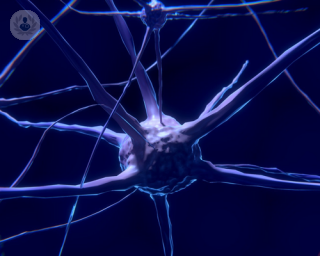Spinal cord stimulator
What is a spinal cord stimulator?
A spinal cord stimulator is an implanted device that sends low levels of electricity directly into the spinal cord to relieve pain. It is used to relieve chronic pain when nonsurgical pain treatment has failed to provide relief.

Spinal cord stimulators consist of thin wires (electrodes) and a small pacemaker-like battery (generator). The electrodes are placed between the spinal cord and epidural space and the generator is placed under the skin. Patients can send electrical impulses using a remote control whenever they feel pain.
Why would someone need a spinal cord stimulator?
A spinal cord stimulator is implanted in patients to relieve chronic pain, when other pharmacological, rehabilitative and minimally invasive treatments have not achieved pain relief.
A spinal cord stimulator is recommended for patients with:
- Back pain, especially pain that continues after surgery (failed back surgery syndrome)
- Arachnoiditis (inflammation of the membrane that covers the brain and spinal cord)
- Angina
- Nerve-related pain such as diabetic neuropathy
- Regional pain syndrome
- Peripheral vascular disease
- Visceral abdominal pain and perineal pain
What does the implantation of a spinal cord stimulator involve?
Spinal cord stimulator surgery requires two procedures; a test and the implantation.
The trial period involves implanting a temporary device for the patient to test out. An incision is made in the lower back. The surgeon implants electrodes into the epidural space of the spine, guided by an X-ray called fluoroscopy. The generator remains outside the body, typically on a belt. The trial device is used for about a week. If the patient’s pain has been reduced by at least 50%, the proper implantation of a spinal cord stimulator will be carried out.
The implantation procedure involves replacing the trial electrodes with sterile electrodes and the generator is placed under the skin. The implantation can take between one to two hours and is performed under local anaesthesia. An incision is made along the lower abdomen to insert the generator and along the spine to insert the permanent electrodes.
What does post-operative care look like?
Most patients can leave on the day of the procedure, once the anaesthesia has worn off. The areas where the incisions were made may be painful for several days. It’s advised not to stretch or twist too much to avoid opening the incisions. Any dressings can be removed after three days and will be healed fully within two to four weeks.
It’s recommended to participate only in light activities for one to two weeks after surgery.












